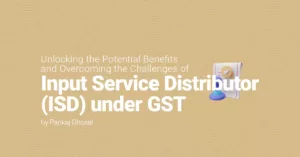The world today is realigning of its economic and financial forces and such global developments have brought India into the spotlight. Being one of the fastest growing economies, the country also is undergoing radical changes in every sphere of its business landscape.
Past few years have witnessed significant reforms with increased level of digitisation, somewhat simplified compliances, tax reforms and eased-out regulatory norms. Consequently, India has seen an impressive GDP growth of 7-7.5% in the past three years, increased foreign direct investment (FDI) movement in India and significant push in the infrastructure sector. Also, as most will know, India has moved up by 30 ranks in the World Bank’s Ease of Doing Business index, 2017.
Though India’s endeavour to bring its practice in-line with international standards continues, the tax structure in the country remains rather complex, still being one of the biggest deterrents to doing business in India.
Through this article, we highlight not only the significant factors that have paved the way for an emerging India but also the elements that still need improvements. Our purpose in doing so, is to inform multinational businesses of initiatives that can be taken advantage of and what businesses can expect going forward.
New initiatives and strong policy reforms
Over the past few years, the Government of India has made significant policy reforms to eliminate various bottlenecks and to make business environment more conducive for growth. For example, adoption of technology and digitisation in various processes has helped to simplify the process against the earlier offline systems. Now, be it the incorporation of a company, payment of taxes, or procuring construction permits, almost everything can be done online. The Hon’ble Finance Minister in recent budget speech also mentioned that the Government will explore use of block chain technology proactively for ushering in digital economy era in India. Demonetisation further led to the rapid adoption of digitised banking transaction flow.
Soon after demonetization was enforced, India witnessed one of its biggest taxation reforms in the form of the introduction of the Goods and Services Tax (GST). Brought into effect from July 1, 2017, GST consolidated multiple indirect taxes in India and brought many businesses into the tax fold. ‘Indian Customs Single Window Project’ has been successfully implemented and should result in a positive facilitation of trade.
Advent of new insolvency code has consolidated rules and laws relating to insolvency into a single legislation. This has resulted in improving investors’ confidence and increased availability of credit by strengthening procedures. FDI Policy regime has also undergone radical changes in past some time. Liberalization in 87 policy areas across 21 sectors, bringing most sectors under automatic route, increasing sectoral cap to 100% in major sectors such defence, aviation, single brand retail trading will soon be seen to be paying off.
Also, an economy cannot grow without giving the necessary push to its infrastructure sector. The Indian Government being cognizant of this fact has taken desired initiatives. New railway lines and roads are being constructed, 5 new industrial corridors are coming up. Major steps have also proven successful in the widespread electrification across regions in India – particularly rural areas.
To make the economy’s growth sustainable and uniform, stringent measures were implemented to unearth black money. Be it the demonization drive of the government or the increased focus on tax compliance, all of these have led to a widening of the tax base and an increased transparency for investors.
Based on our practical experience, we can say that the complex tax and regulatory system in India does remain one of the biggest concerns for people intending to do business in India. However persistent effort to ease out the policies and reform tax administration is something to watch out for.
Ease of doing business in India
As already mentioned above India has moved up 30 ranks in ease of doing business as per World Bank’s report. This phenomenal growth has been centred around multiple policy and strategy level initiatives taken by government for reforming business environment.
Gone are the days when multiple forms were to be submitted to incorporate a company in India. Today, it can be done by filing only one form – “SPICe”. Even the name reservation process is now online. Fast track mergers regime is here. Directors can participate in Board meetings through video conferencing.
Synergies have been brought into FDI as well. With granting of permission for 100% FDI in single brand retail trading under automatic route, one can surely expect to see more swanky stores exclusively for brands such as Louis Vuitton bags, Ikea furniture, or Cartier watches in the near future! Even the downstream investments made by Indian companies regulated by the financial sector regulator are now allowed upto 100% FDI under the automatic route.
In the case of inflow of funds by way of ECB, the list of ‘eligible borrowers’ has been expanded. Also, a common negative ‘end use prescription’ list has been prescribed for all tracks of course with only a few exceptions. This recent rationalization and liberalization of ECB norms should be a big positive for companies entering Indian markets.
Measures have been taken to shift tax income tax assessments/audits from manual interface to online portal. Even the manual selection of cases for audits has been done away with.
One of the biggest contributors to tax litigation is India was transfer pricing. The safe harbor rules and advance pricing agreements (APA) implemented provide the much-needed certainty regarding the arm’s length price of transactions. APA, arguably, seems to be one of the most successful initiative on tax front in the recent past. Significant number of APAs include bilateral APAs have been concluded, providing much needed certainty to tax payers on transfer pricing matters.
The Authority for Advance Ruling (AAR) enables the non-resident taxpayer to obtain in advance certainty on tax positions of transactions. This helps the tax payer in pre-planning their income tax affairs rather than going for long drawn litigations. The AAR has resumed its functioning and one can expect to see non-resident taxpayers using this mechanism to reduce uncertainty as far as India tax matters are concerned, by approaching AAR. Resolution of issues regarding double taxation by negotiation between competent authorities of countries through mutual agreement procedure has also been thrown into action.
Our recent experience suggests that tax authorities have started to adopt a more collaborative approach towards honest taxpayers. Recently, moving one step ahead, the Indian Tax department sent notices to Walmart and Flipkart seeking details of acquisition and enlightening both the parties about the applicable tax provisions on the acquisition transaction. This demonstrates the willingness of authorities to work proactively rather than causing undue hardships later.
Coherence with International standards
To ensure that its mandate for economic growth is also global in nature, the Government has taken steps to make the taxation system and accounting procedures coherent with the ones existing internationally.
One major such initiative by the Government was the introduction of GST in India. Undoubtedly, since its implementation in July 2017, the taxpayers have and still face multiple challenges. But regular attempts have been made to resolve the bottlenecks in its implementation and ensure greater transparency to remove cascading effect of taxes.
However, the unified implementation of GST is still facing bottlenecks such as:
- Difficulties in GST self-assessments with GST department due to unavailability of an annual return/other form
- Blockage of GST refunds unless an audit is completed/ annual return is filed
- Lack of options for return revision and non-grant of provisional credit unless return filed by the vendor
However, we believe it is just a matter of time that will make the GST processes simple and efficient.
Considering the financial reporting landscape in India, introduction of the Indian Accounting Standards (Ind AS) has been a monumental change. In an endeavor to streamline our accounting methodologies with international standards, the Government introduced Ind AS for companies in convergence with IFRS, (though not its pure adoption). They have been implemented in two phases:
- Phase 1 w.e.f. 1 April 2016 for companies having Net worth of INR 500 Cr or more;
- Phase 2 w.e.f. 1 April 2017 for all other listed/ in process of listing companies and unlisted companies having Net worth INR 250 Cr or more.
On one hand, the Ind AS will make financial statements comparable across countries and competitors, and on the other the conversion journey shall extend beyond the accounting to process, people, controls, and technology.
With the way markets have evolved, the way businesses operate globally has gone through a radical change. Taxation laws and procedures were failing to keep pace with such evolving business models. It is to resolve this issue that the Organisation for Economic Co-operation and Development [OECD] started its work on the Base Erosion Profit Shifting (BEPS) project. The main objective of the BEPS Action Plans is to tax profits where economic activities are actually carried out and where value is created. India has always been at forefront in implementation of the BEPS initiative.
Following are the few changes flowing from BEPs action plan that have been implemented in India:
- Equalization Levy (EL) – EL is the Indian version of Google Tax, aimed at taxing B2B e-commerce transactions.
- Significant Economic presence (SEP) – Nowadays, taxing principles based on physical presence are rather obsolete. Physical presence at a location is no longer a true measure of the benefits derived from those locations. SEP seeks to address this issue by levying tax on companies having significant economic presence in India irrespective of their physical location.
- Thin capitalisation rules aimed at capping the interest expenditure of a company.
- General Anti Avoidance Rules (GAAR) to prevent tax abuse by transactions lacking commercial substance. Signifying the importance of Substance over form.
- Transfer pricing provisions – India in order to align transfer pricing outcomes with value creation has made significant changes in the documentation requirements in lines with the BEPS project
- Multilateral Instruments (MLI): It is impossible to talk about BEPS, without addressing MLI. Signed by 78 jurisdictions (including India), MLI may be considered to be one of the key outcomes of the BEPS project which would ensure the implementation of the recommended BEPS Action Plans. MLI has been designed to be read along with existing tax treaties.
- The scope of business connection definition has been widened to include agents habitually playing a principal role in the conclusion of a contract. It seeks to cover situations wherein an agent in India, though is not habitually concluding contracts, but habitually plays a principal role in its conclusion. Now it will be interesting to see how the tax are levied on foreign companies availing marketing support services from their Indian arm.
Other Evolving Areas
The newly implemented insolvency law – Insolvency and Bankruptcy Code, 2016 (IBC) is one of the largest reform in Indian banking sector. It consolidates the previous insolvency resolution framework by creating a single law for insolvency and bankruptcy. The law mandates that insolvencies are resolved in a time bound manner, i.e. within 270/180 days. It intends to transfer control from existing promoters to lenders and resolving confusions of the erstwhile law. Also, Asset Reconstruction Companies have been created to manage and recover Non-performing Assets from banks. Given the prospects of the overall Indian market, this new law provides immense potential for funds to invest into distressed assets in India at discounted prices.
The applicability of Income Computation and Disclosure Standards (ICDS) has long been contentious issue. However, the position on its applicability is relatively settled as of today. The application of ICDS shall be restricted to computation of income chargeable under the head Profits and gains of business or profession and Income from other sources and shall not be meant for the maintenance of books of account, which shall be done as per applicable AS/Ind AS. Till date 10 ICDS have been notified with effect from AY 2017-18, which are applicable to all taxpayers (except individuals or HUFs whose turnover/gross receipts do not exceed Rs. 1 Crore (in case of businesses) or whose gross receipts do not exceed Rs. 50 Lakhs). It is also settled now that the provisions of the Act will prevail in the case of conflicts with ICDSs, however the provisions of ICDS will prevail over inconsistent judicial precedents.
Closing Remarks
It may be summarised that India has already set sails for a journey of economic growth, driven by strong policy reforms and a keen focus on ease of doing business. The world continues to keenly watch the political and economic development in India.
Over the next 12-18 months, a definitive key event would be the Union election scheduled in 2019. With current political situation, which can at best be termed as ‘non-cooperative’, if not hostile, leading to parliamentary deadlock at many occasions, everyone would be interested in results of Union Elections. The other aspect to watch out for could be Rupee performance against major currencies. This could have significant impact of trade balance and fiscal performance of India.
Nonetheless, we believe that India is poised for interesting times ahead, with a lot of opportunities and challenges combined together.
Link to Presentation: https://www.slideshare.net/thebrief_coinmen/india-trends-2018
—
Written by Nitin Garg
Nitin Garg is a Partner and Co-founder at Coinmen Consultants LLP










